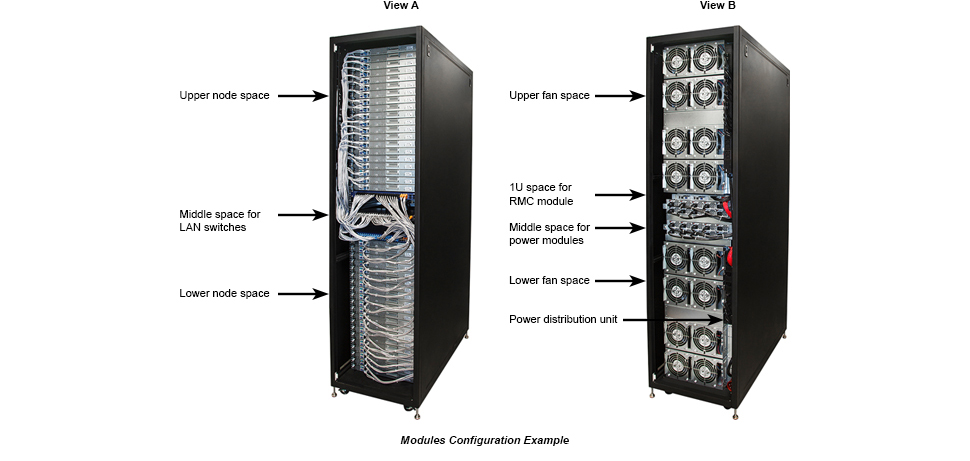What is Open Rack?
| The Open Compute Project | The Open Rack Standard |
|---|---|
| The Open Compute Project is an initiative that has been launched in 2011 by Facebook with the purpose to design and share innovative specifications for better datacenters. You can find more details on the project's official website. | The Open Rack standard, as its name suggests, focuses on the datacenter rack itself and on the way it is designed and its nodes organized and configured. It includes a whole set of design guides and specifications that can be found on the standard's webpage. |
GIGABYTE's Open Rack
Studying and developing on the Open Rack standard since its early stages, GIGABYTE is now producing datacenter racks and nodes that can outperform most of today's solutions designed according to the traditional approach. Several clearly distinguishable concepts and features are behind this achievement that has already led several datacenters around the world to identify GIGABYTE's systems as the best solution for their infrastructure:
A Modular Design
Unlike the traditional approach where each system fitted into the rack is a full featured server, with GIGABYTE's Open Rack the redundant functions between all the different rack-mount systems are removed and consolidated into the rack itself. This leaves primary rack-mounts that serve a main function only, such as pure computing, storage, or computing/storage hybrids, and support modules providing the previously redundant functions. Those support modules, all located at the rear of the rack, include:
- Fan modules that accommodate heavy duty 5U fans, much bigger than the ones usually installed in standard rack-mounts. They deliver significantly better cooling performance and power efficiency.
- A power bank module that can receive enough standard server power supply units for the whole rack's needs (supports up to 32kW). It regroups and connects them to a rack-level power distribution unit in which the primary rack-mounts can be hot-plugged, in the same fashion as a storage backplane. This power distribution unit and the primary rack-mounts connectors are all made of pure copper for the best power distribution efficiency. This consolidation of the power supplies also allows for more redundancy configuration possibilities between them.

- A remote management controller module, serving as a gateway for the management related traffic between the sub-rack and super-rack levels. This module is capable, among others, of real time fan speed optimization, comprehensive rack asset management (with rack IDs, node IDs, asset tags, and so on), and full featured power management.

Excellence in Power Efficiency
Thanks to the consolidation of the rack's power supplies into a single module that is cooled and managed more efficiently than individual power supplies integrated into each rack-mount, the total energy consumption of an Open Rack is significantly lower than a traditional rack. The table below shows the average power savings realized with GIGABYTE's Open Rack compared to a comparable traditional rack fitted with 1U rack-mounts, both equipped with Intel Xeon E5-2600 processors:

Achieved through a real-time on-demand power delivery adjusted to each individual rack-mount, these power savings number make particular sense in many cloud applications where the resource demand fluctuations seldom lead to loadings above 50%. Yet in case of peak demands, GIGABYTE Open Rack solution is still capable of delivering significant energy savings nearing 10% compared to traditional racks.
High Node Density
As mentioned above, all the power supply, cooling, switching and monitoring devices disappear from the rack-mounts, and in this way their surface can be fully available to accommodate hardware serving their primary function. The space efficiency is therefore greatly increased within the nodes, without decreasing their actual dimension compared to traditional racks.
You can check our different nodes available in the "Nodes" tab.
Scalability
With its fully modular design, GIGABYTE's Open Rack solution is also ready for the growth and evolution of the datacenter. Each module is available individually and can be ordered later in time to add capacity to the existing infrastructure. With such flexibility, our customers can setup a configuration matching the current need of their application, and as time passes they are able to complete, scale and upgrade their park as the demand for their service develops. Moreover, GIGABYTE's Open Rack is based on the standard 19" rack design, which means existing racks in a datacenter can receive the internal Open Rack structure, and non-Open Rack rack-mounts can also fit into an Open Rack cabinet. The implementation of the Open Rack standard can therefore happen without any major overhaul of an existing datacenter's design and parameters.
Easy Assembly & Handling
Once again, it is thanks to its modular design that GIGABYTE's Open Rack can be easily assembled and handled. All the modules can be handled by a single operator, without the help of elevating tools usually required for 2U or thicker rack-mounts. Moreover, each module is designed with as few screws as possible, and all of them are easily swappable for the smoothest daily handling possible.
Our Available Open Rack Configurations
| Height | Power Bank (Set / Max. Watts) |
LAN Switch Space | Main Node Space | Total Number of Nodes (Dual Node Racks) |
Total Number of Nodes (Single Node Racks) |
|---|---|---|---|---|---|
| 47U | 2 / 32kW | 7 | 20U + 20U | 80 | 40 |
| 25U | 1 / 16kW | 5 | 10U + 10U | 40 | 20 |
